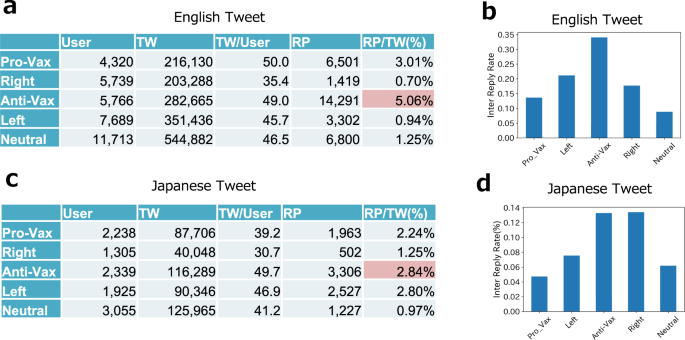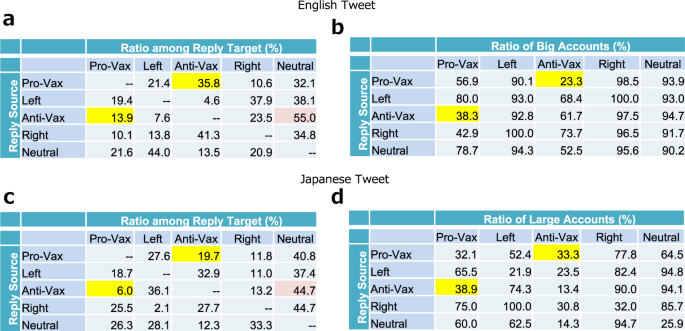Aggressive behaviour of anti-vaxxers and their toxic replies in English and Japanese | Humanities and Social Sciences Communications
Communities related to vaccine discourse
We constructed the retweet (RT) networks from the COVID-19 tweets to identify anti-vaxxers and other groups (see Methods). The resulting networks are illustrated in Fig. 1a for English and 1c for Japanese. Figure 1b, d illustrate popular words used in each group.
We found five clusters or groups in English tweets (Fig. 1a). Although these groups commonly used factual words related to COVID-19 and vaccines (‘trial’, ‘response’), they also used different keywords specific to each group (Fig. 1b). One group paid much attention to the efficacy and the evidence of vaccines (‘efficacy’, ‘the lancet’), suggesting the Pro-Vax group. Another group focused on conspiracy theories and criticism of the government (‘bill’, ‘fauci’Footnote 6,Footnote 7), suggesting the Anti-Vax cluster; especially, a large portion of conspiracies consisted of Bill Gates, one of the biggest proponents of vaccinationFootnote 8. Another group that mentioned the topics of Bill Gates’s investment in vaccines and some political names (‘bill’, ‘billion’, ‘kennedy’, ‘realdonaldtrump’) seemed to be a political right cluster, whereas the one that contained words for politics and government (‘trump’, ‘house’) seemed to be a politically left cluster. In addition, we identified one that contained vaccine makers, universities, and news media outlets (‘cnn’, ‘oxford’, ‘pfizer’, ‘moderna’) as a neutral cluster. We further confirmed the above observations by checking each group’s retweeted accounts and tweets for each group (see Supplementary Information (SI)). While in most clusters, the popular accounts included various users, such as politicians, journalists, doctors, anonymous influencers, and organisations (WHO, the White House), the neutral cluster was mainly occupied by news media, such as CNN and Reuters (see SI).
The comparable five clusters with topic structures emerge in the Japanese dataset (Fig. 1c): the pro- and anti-vaxxers, the political Left and Right clusters, and the Neutral cluster. Besides factual words (‘inoculation’, ‘development’), the Pro-Vax group used words related to the efficacy of vaccinations (‘prevention’, ‘effect’), whereas the Anti-Vax group used words related to conspiracy theories and criticism of the government (‘gates’, ‘ministry’Footnote 9). In the political clusters, the Right cluster criticised China (‘china’), whereas the Left group criticised the government (‘ministry’). In addition to Japanese news media, vaccine makers’ accounts (‘astrazeneca’) and words related to the possibility of vaccination (‘realisation’, ‘clinical trial’) were found in the neutral group. Thus, the vaccine information ecosystems demonstrate striking similarities in English and Japanese, although they have different vaccine policies and political backgrounds. This structural and topical resemblance suggests that vaccination is a common political matter across countries (Sharun and Dhama, 2021), and was perhaps weaponised during the COVID-19 infodemic (Broniatowski et al., 2018; Jamison, 2020). To vaccinate or not is a matter of intersection between personal freedom and public health policy (DiResta, 2018). Therefore, the vaccine topic may intensify conflicts between groups with different ideologies and beliefs, which will be further discussed later.
Active reply by anti-vaxxers
After identifying the groups, we analysed how actively anti-vaxxers targeted other groups using replies. Figure 2a, c illustrate that both in English and Japanese, anti-vaxxers were the most active in reply behaviour. Looking at the reply frequencies in inner-cluster (i.e., replies to the same cluster) and inter-cluster (i.e., replies to the other clusters) conditions, we find two similarities in both languages. While most replies were directed towards the same cluster (inner-cluster), the Anti-Vax groups sent the largest number of inter-replies (n.b., the Right cluster is comparable in Japanese). Thus, anti-vaxxers are supposed to be more enthusiastic about reaching out to people with other beliefs. In contrast, pro-vaxxers sent out direct messages to external clusters at a lower frequency according to the inter-reply rate, although they should have contributed to disseminating the correct knowledge about the COVID-19 vaccination.
a Reply activities of each cluster in English tweets. Here, TW: tweets. RP: replies. TW includes normal tweets, RP, and RT. Reply rate (RP/TW) was significantly higher in the Anti-Vax cluster (χ2 test: p < 0.001, illustrated in rad shades); b Ratio of inter-cluster replies per all replies from each cluster in English tweets; c and d are the Japanese counterparts.
Reply targets of anti-vaxxers
Next, we examined the main targets of anti-vaxxers (Fig. 3a, d). Although all the groups were mainly targeting the Neutral group, the Anti-Vax groups had this tendency more apparent than others (shaded in red) in both languages (especially in English). This result is consistent with the findings of previous research that anti-vaxxers are more entangled with neutral groups than pro-vaxxers and thus, successful in their reach (Johnson et al., 2020). On the contrary, the rate of replies from Anti-Vax to Pro-Vax is lower than that of their opposite counterparts in both languages (shaded in yellow). This asymmetry in reply frequency suggests that the Anti-Vax group tends to neglect the Pro-Vax group.
Furthermore, we found that the reply targets have large numbers of followers, and the median scores of followers of reply receivers are much larger than those of reply senders (see SI). To quantify the tendency of replies toward influential accounts, we calculated the percentage of replies directed to accounts with more than 10,000 followers (Fig. 3c, f)Footnote 10. We found that most of these neutral accounts have numerous followers, and the neutral accounts that received the most replies from anti-vaxxers were media and politicians’ accounts. Contrarily, the percentage of replies from anti-vaxxer to pro-vaxxer groups was considerably small (shaded in yellow).
Highly toxic replies by anti-vaxxers
To characterise the nature of anti-vaxxers’ inter-replies (i.e., replies to other groups), we measured the toxicity of languages used in replies (see Methods) and tested the differences between inter- and inner-replies in each group (Fig. 4a, d). We found that the inter-cluster replies were significantly higher than the inner-cluster replies in both languages.
a Median toxicity scores of inner-cluster and inter-cluster replies from each cluster. The Anti-Vax’s inter-cluster replies have a significantly higher toxicity score than its inner-cluster replies. The Left’s inner-cluster replies have a significantly higher toxicity score than its inter-cluster replies. Both have p < 0.001 by Mann–Whitney U-test with Bonferroni correction. b Boxplots represent the toxicity of the inter-cluster replies from each cluster. Each data point indicates the toxicity of a reply. Each median score is annotated in the boxes. Replies from the Anti-Vax cluster were significantly more toxic than ones from the Pro-Vax and Neutral clusters in both languages (***p < 0.001 by Mann–Whitney U-test with a Bonferroni correction). c The maximum toxicities that one received from Anti-Vax users. Each data point in the figure is the users who received the reply. The x-axis is the number of followers of the users, and the y-axis is the toxicity of the replies received. The correlation coefficients are d: 0.02 (p = 0.601), e: 0.198 (p < 0.001), h: 0.096 (p = 0.254), and 0.268 (p < 0.005). d, e, and f are Japanese counterparts of a, b, and c, respectively.
The toxicity of the inter-reply is compared between clusters in Fig. 4b, e. This reveals that the toxicity of the Anti-Vax’s inter-reply is higher than the other groups, especially significantly higher than those of the Pro-Vax and Neutral groups in both English and JapaneseFootnote 11. Next, we examined who was more likely to receive a highly toxic reply from the Anti-Vax group. Looking at the toxicity of Anti-Vax’s inter-cluster replies by target (see SI), it was found that the Anti-Vax’s high toxicity is significantly directed at the Right cluster in English tweets. Upon scrutinising the content of the highly toxic replies from Anti-Vax to Right, we found that most of the replies were among the lines of ‘Don’t spread the vaccine’. As the Trump administration was in power, it seems that complaints and requests were made against the administration with high aggressiveness, even though the Right cluster was close to the Anti-Vax cluster in the RT network. On the contrary, in Japanese tweets, most of the toxic replies from Anti-Vax to Right were about criticism against the administration party, although they were not concerned with the vaccine rollout. The toxicity from the Anti-Vax to Right clusters was not significantly high compared to those of other clusters.
Moreover, we found a positive correlation between toxicity and the number of followers of the target of Anti-Vax replies both in English and Japanese. Figure 4c, f illustrate the max toxicities one received from Anti-Vax users, indicating that users with many followers are more likely to receive replies with high toxicity. In English, however, there are a certain number of accounts with a small number of followers that still receive highly toxic replies, and if we view them as less tolerant of toxicity than people with larger followings, they should be careful about the toxic replies. We cannot find this tendency in Japanese tweets.
Finally, we evaluated the emotions of inter-cluster replies. Compared with the other clusters, replies from the Anti-Vax cluster contained more negative and fewer valence words in both English and Japanese, although the less use of positive words is apparent in English only (Fig. 5). This result is consistent with the finding that the Anti-Vax users’ replies are toxic and thus negative.
This article has been archived for your research. The original version from Nature.com can be found here.






